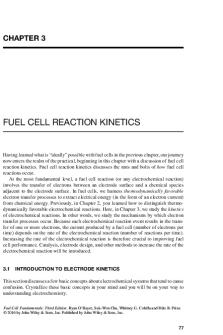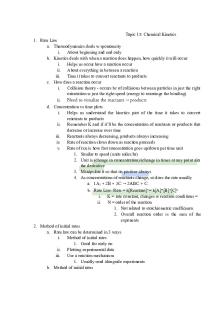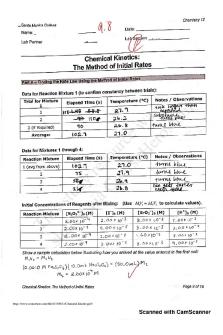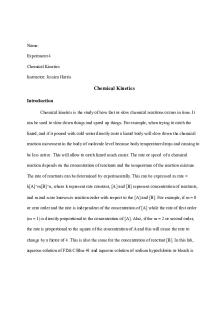Missen- Introduction To Chemical Reaction Engineering And Kinetics PDF

| Title | Missen- Introduction To Chemical Reaction Engineering And Kinetics |
|---|---|
| Author | Silvia Jy |
| Pages | 692 |
| File Size | 10.3 MB |
| File Type | |
| Total Downloads | 339 |
| Total Views | 390 |
Summary
INTRODUCTION T O CHEMICAL REACTION Ronald W. Missen Charles A. Mims Bradley A. Saville INTRODUCTION TO CHEMICAL REACTION ENGINEERING AND KINETICS INTRODUCTION TO CHEMICAL REACTION ENGINEERING AND KINETICS Ronald W. Missen Charles A. Mims Bradley A. Saville Department of Chemical Engineering and Appl...
Description
IN T R O D U C T IO NT
O
CHEMICAL REACTION
Ronald W. Missen Charles A. Mims Bradley A. Saville
INTRODUCTION TO CHEMICAL REACTION ENGINEERING AND KINETICS
INTRODUCTION TO CHEMICAL REACTION ENGINEERING AND KINETICS Ronald W. Missen Charles A. Mims Bradley A. Saville Department of Chemical Engineering and Applied Chemistry University of Toronto
John Wiley & Sons, Inc. New York l Chichester
l
Weinheim
l
Brisbane
l
Singapore
l
Toronto
No. ADQUIS!CII?N 02”2’:-34 C~SIFICAGCN _ ***“**--.- . . . . . . . . . . . . . . . . . . . ..yCT”AA _._. .&-;;~~g@ . . . . . . . . . . . . . . . ...-.” -*... . . . . . . . . . 2.335,,, FEWA . . . . . . . . . . . . . . ...I.....zA,.~ EJ. *--=**. . . . . . . . . ..._.._._._... “_ v _‘(I....... . . . . . . . . . . . . . . “.. ’ --- . . . . . - . . . . . . . . . . . . . . I-
Acquisitions Editor Marketing Manager Freelance Production Manager Designer Illustration Editor Outside Production Management Cover Design
Wayne Anderson Katherine Hepburn Jeanine Furino Laura Boucher Gene Aiello Hermitage Publishing Services Keithley Associates
This book was set in Times Ten by Publication Services and printed and bound by Hamilton Printing. The cover was printed by Lehigh Press. This book is printed on acid-free paper. @ The paper in this book was manufactured by a mill whose forest management programs include sustained yield harvesting of its timberlands. Sustained yield harvesting principles ensure that the number of trees cut each year does not exceed the amount of new growth. Copyright 1999 0 John Wiley & Sons, Inc. All rights reserved. No part of this publication may be reproduced, stored in a retrieval system or transmitted in any form or by any means, electronic, mechanical, photocopying, recording, scanning or otherwise, except as permitted under Sections 107 and 108 of the 1976 United States Copyright Act, without either the prior written permission of the Publisher, or authorization through payment of the appropriate per-copy fee to the Copyright Clearance Center, 222 Rosewood Drive, Danvers, MA 01923, (508) 7508400, fax (508) 750-4470. Requests to the Publisher for permission should be addressed to the Permissions Department, John Wiley & Sons, Inc., 605 Third Avenue, New York, NY 101580012, (212) 850-6011, fax (212) 850-6008, E-Mail: [email protected]. Library of Congress Cataloging-in-Publication Data: Missen, Ronald W. (Ronald William), 192% Introduction to chemical reaction engineering and kinetics / Ronald W. Missen, Charles A. Mims, Bradley A. Saville. p. cm. Includes bibliographical references and index. ISBN 0-471-16339-2 (cloth : alk. paper) 1. Chemical reactors. 2. Chemical kinetics. I. Mims, Charles A. II. Saville, Bradley A. III. Title. TP157.M538 1999 660’.2832-dc21 98-27267 CIP Printed in the United States of America 1098765432
Introduction to Chemical Reaction Engineering and Kinetics is written primarily for
a first course in chemical reaction engineering (CRE) for undergraduate students in chemical engineering. The purpose of the work is to provide students with a thorough introduction to the fundamental aspects of chemical reactor analysis and design. For this purpose, it is necessary to develop a knowledge of chemical kinetics, and therefore the work has been divided into two inter-related parts: chemical kinetics and CRE. Included with this book is a CD-ROM containing computer software that can be used for numerical solutions to many of the examples and problems within the book. The work is primarily based on material given to undergraduate students in the Department of Chemical Engineering and Applied Chemistry at the University of Toronto.
Scope and Organization of Material The material in this book deals with kinetics and reactors. We realize that students in many institutions have an introduction to chemical kinetics in a course on physical chemistry. However, we strongly believe that for chemical engineering students, kinetics should be fully developed within the context of, and from the point of view of, CRE. Thus, the development given here differs in several important respects from that given in physical chemistry. Ideal-flow reactor models are introduced early in the book (Chapter 2) because of their use in kinetics investigations, and to get students accustomed to the concepts early. Furthermore, there is the additional purpose of drawing a distinction between a reaction model (network) or kinetics scheme, on the one hand, and a reactor model that incorporates a kinetics scheme, on the other. By a reaction model, we mean the development in chemical engineering kinetics of an appropriate (local or point) rate law, including, in the case of a multiphase system, the effects of rate processes other than chemical reaction itself. By contrast, a reactor model uses the rate law, together with considerations of residence-time and (if necessary) particle-size distributions, heat, mass, and momentum transfer, and fluid mixing and flow patterns, to establish the global behavior of a reacting system in a vessel. We deliberately separate the treatment of characterization of ideal flow (Chapter 13) and of nonideal flow (Chapter 19) from the treatment of reactors involving such flow. This is because (1) the characterization can be applied to situations other than those involving chemical reactors; and (2) it is useful to have the characterization complete in the two locations so that it can be drawn on for whatever reactor application ensues in Chapters 14-18 and 20-24. We also incorporate nonisothermal behavior in the discussion of each reactor type as it is introduced, rather than treat this behavior separately for various reactor types. Our treatment of chemical kinetics in Chapters 2-10 is such that no previous knowledge on the part of the student is assumed. Following the introduction of simple reactor models, mass-balance equations and interpretation of rate of reaction in Chapter 2, and measurement of rate in Chapter 3, we consider the development of rate laws for single-phase simple systems in Chapter 4, and for complex systems in Chapter 5. This is vii
viii Preface followed by a discussion of theories of reaction and reaction mechanisms in Chapters 6 and 7. Chapter 8 is devoted to catalysis of various types. Chapter 9 is devoted to reactions in multiphase systems. The treatment of chemical kinetics concludes in Chapter 10 with a discussion of enzyme kinetics in biochemical reactions. Our treatment of Chemical Reaction Engineering begins in Chapters 1 and 2 and continues in Chapters 11-24. After an introduction (Chapter 11) surveying the field, the next five Chapters (12-16) are devoted to performance and design characteristics of four ideal reactor models (batch, CSTR, plug-flow, and laminar-flow), and to the characteristics of various types of ideal flow involved in continuous-flow reactors. Chapter 17 deals with comparisons and combinations of ideal reactors. Chapter 18 deals with ideal reactors for complex (multireaction) systems. Chapters 19 and 20 treat nonideal flow and reactor considerations taking this into account. Chapters 2124 provide an introduction to reactors for multiphase systems, including fixed-bed catalytic reactors, fluidized-bed reactors, and reactors for gas-solid and gas-liquid reactions.
Ways to Use This Book in CRJ3 Courses One way in which the material can be used is illustrated by the practice at the University of Toronto. Chapters 1-8 (sections 8.1-8.4) on chemical kinetics are used for a 40-lecture (3 per week) course in the fall term of the third year of a four-year program; the lectures are accompanied by weekly 2-hour tutorial (problem-solving) sessions. Chapters on CRE (ll-15,17,18, and 21) together with particle-transport kinetics from section 8.5 are used for a similarly organized course in the spring term. There is more material than can be adequately treated in the two terms. In particular, it is not the practice to deal with all the aspects of nonideal flow and multiphase systems that are described. This approach allows both flexibility in choice of topics from year to year, and material for an elective fourth-year course (in support of our plant design course), drawn primarily from Chapters 9,19,20, and 22-24. At another institution, the use of this material depends on the time available, the requirements of the students, and the interests of the instructor. The possibilities include: (1) a basic one-semester course in CRE primarily for simple, homogeneous systems, using Chapters 1-4 (for kinetics, if required) and Chapters 11-17; (2) an extension of (1) to include complex, homogeneous systems, using Chapters 5 (for kinetics) and 18 in addition; (3) a further extension of (1) and (2) to include heterogeneous systems using Chapters 8 and 9 (for kinetics), and selected parts of Chapters 21-24; (4) a final extension to nonideal flow, using Chapters 19 and 20. In addition, Chapters 6 and 7 could be reserved for the enrichment of the treatment of kinetics, and Chapter 10 can be used for an introduction to enzyme kinetics dealing with some of the problems in the reactor design chapters. Reviewers have suggested that this book may be used both at the undergraduate level and at the beginning of a graduate course. The latter is not our intention or our practice, but we leave this to the discretion and judgement of individual instructors.
Problem Solving and Computer Tools We place primary emphasis on developing the students’ abilities to establish the working equations of an appropriate model for a particular reactor situation, and of course to interpret and appreciate the significance of quantitative results. In an introductory text in a field such as CRE, it is important to emphasize the development of principles,
Preface ix and to illustrate their application by means of relatively simple and idealized problem situations that can be solved with a calculator. However, with the availability of computer-based solution techniques, it is desirable to go beyond this approach for several reasons: (1) Computer software allows the solution of more complex problems that require numerical, as opposed to analytical, techniques. Thus, a student can explore situations that more closely approximate real reactor designs and operating conditions. This includes studying the sensitivity of a calculated result to changing operating conditions. (2) The limitations of analytical solutions may also interfere with the illustration of important features of reactions and of reactors. The consequences of linear behavior, such as first-order kinetics, may be readily demonstrated in most cases by analytical techniques, but those of nonlinear behavior, such as second-order or Langmuir-Hinshelwood kinetics, generally require numerical techniques. (3) The development of mechanistic rate laws also benefits from computer simulations. All relevant elementary steps can be included, whereas, with analytical techniques, such an exploration is usually impossible. (4) Computer-aided visual demonstrations in lectures and tutorials are desirable for topics that involve spatial and/or time-dependent aspects. For these reasons, we include examples and problems that require numerical techniques for their solution together with suitable computer software (described below).
v 0“OP
Computer Software: E-Z Solve: The Engineer’s Equation Solving and Analysis Tool Accompanying this book is a CD-ROM containing the computer software E-Z Solve, developed by IntelliPro, Inc and distributed by John Wiley & Sons, Inc. It can be used for parameter estimation and equation solving, including solution of sets of both nonlinear algebraic equations and differential equations. It is extremely easy to learn and use. We have found that a single 2-hour tutorial is sufficient to instruct students in its application. We have also used it in research problems, such as modeling of transient behavior in kinetics investigations. Other computer software programs may be used, if appropriate, to solve most of the examples and problems in the text that are solved with the aid of E-Z Solve (indicated in the text by a computer icon shown in the margin above). The successful use of the text is not restricted to the use of E-Z Solve for software support, although we encourage its use because of its capabilities for nonlinear parameter estimation and solution of coupled differential and algebraic equations. Appendix D provides examples illustrating the use of the software for these types of problems, along with the required syntax.
Web Site A web site at www.wiley.com/college/missen is available for ongoing support of this book. It includes resources to assist students and instructors with the subject matter, such as sample files, demonstrations, and a description of the E-Z Solve software appearing on the CD-ROM that accompanies this book.
Acknowledgments We acknowledge our indebtedness to those who have contributed to the literature on the topics presented here, and on whose work we have drawn. We are grateful for the
x Preface contributions of S.T. Balke, W.H. Burgess, and M.J. Phillips, who have participated in the undergraduate courses, and for discussions with W.R. Smith. We very much appreciate the comments on the manuscript received from reviewers. CAM credits, in addition to his academic colleagues, his former coworkers in industry for a deep and continuing education into the subject matter. We are also grateful for the assistance given by Esther Oostdyk, who entered the manuscript; by Lanny Partaatmadja, who entered material for the “Instructor Resources”; and by Mark Eichhorn, Nick Palozzi, Chris Ho, Winnie Chiu and Lanny Partaatmadja, who worked on graphics and on problems for the various chapters. We also thank Nigel Waithe, who produced copies of draft material for the students. We thank our students for their forbearance and comments, both written and oral, during the development of this book. The development of the computer tools and their integration with the subject matter required strong support from Wayne Anderson and the late Cliff Robichaud at Wiley, and Philippe Marchal and his staff at Intellipro. Their assistance is gratefully acknowledged. We also thank the staff at Wiley and Larry Meyer and his staff at Hermitage Publishing Services for their fine work during the production phase. Support for the development of the manuscript has been provided by the Department of Chemical Engineering and Applied Chemistry, the Faculty of Applied Science and Engineering, and the Office of the Provost, University of Toronto. Ronald W. Missen Charles A. Mims Bradley A. Saville Toronto, Ontario. May, 1998
Contents
1 . INTRODUCTION 1 1.1 Nature and Scope of Chemical Kinetics 1 1.2 Nature and Scope of Chemical Reaction Engineering 1.3 Kinetics and Chemical Reaction Engineering 2 1.4 Aspects of Kinetics 3 1.4.1 1.4.2 1.4.3 1.4.4 1.4.5 1.4.6
Rate of Reaction-Definition 3 Parameters Affecting Rate of Reaction: The Rate Law Measurement of Rate of Reaction-Preliminary 5 Kinetics and Chemical Reaction Stoichiometry 6 Kinetics and Thermodynamics/Equilibrium 14 Kinetics and Transport Processes 15
1.5 Aspects of Chemical Reaction Engineering 15 1.5.1 1.5.2 1.5.3 1.5.4
Reactor Design and Analysis of Performance 15 Parameters Affecting Reactor Performance 16 Balance Equations 16 An Example of an Industrial Reactor 18
1.6 Dimensions and Units 19 1.7 Plan of Treatment in Following Chapters
21
1.7.1 Organization of Topics 21 1.7.2 Use of Computer Software for Problem Solving
21
1.8 Problems for Chapter 1 22 ,-. 2 . KINETICS AND IDEAL REACTOR MODELS 2.1 Time Quantities 25 2.2 Batch Reactor (BR) 26
25
2.2.1 General Features 26 2.2.2 Material Balance; Interpretation ri of 27
2.3 Continuous Stirred-Tank Reactor (CSTR) 29 2.3.1 General Features 29 2.3.2 Material Balance; Interpretation of ri 31
2.4 Plug-Flow Reactor (PFR) 33 2.4.1 General Features 33 2.4.2 Material Balance; Interpretation ri of 34
2.5 2.6 2.7 2.8 3
l
Laminar-FIow Reactor (LFR) 36 Smnmary of Results for Ideal Reactor Models Stoichiometric Table 39 Problems for Chapter 2 40
EXPERIMENTAL METHODS IN KINETICS: MEASUREMENT OF RATE OF REACTION 3.1 Features of a Rate Law: Introduction 42
38
42
3.1.1 Separation of Effects 42 3.1.2 Effect of Concentration: Order of Reaction 42 3.1.3 Effect of Temperature: Arrhenius Equation; Activation Energy
44
xi
x ii Contents 3.2 Experimental Measurements: General Considerations 45 3.3 Experimental Methods to Follow the Extent of Reaction 46 3.3.1 Ex-situ and In-situ Measurement Techniques 46 3.3.2 Chemical Methods 46 3.3.3 Physical Methods 47 3.3.4 Other Measured Quantities 48 3.4 Experimental Strategies for Determining Rate Parameters 48 3.4.1 Concentration-Related Parameters: Order of Reaction 49 3.4.2 Experimental Aspects of Measurement of Arrhenius Parameters A and EA 3.5 Notes on Methodology for Parameter Estimation 57 3.6 Problems for Chapter 3 61 4 . DEVELOPMENT OF THE RATE LAW FOR A SIMPLE SYSTEM 4.1 The Rate Law 64 4.1.1 Form of Rate Law Used 64 4.1.2 Empirical versus Fundamental Rate Laws 65 4.1.3 Separability versus Nonseparability of Effects 66 4.2 Gas-Phase Reactions: Choice of Concentration Units 66 4.2.1 Use of Partial Pressure 66 4.2.2 Rate and Rate Constant in Terms of Partial Pressure 67 4.2.3 Arrhenius Parameters in Terms of Partial Pressure 68 4.3 Dependence of Rate on Concentration 69 4.3.1 First-Order Reactions 69 4.3.2 Second-Order Reactions 71 4.3.3 Third-Order Reactions 72 4.3.4 Other Orders of Reaction 75 4.35 Comparison of Orders of Reaction 75 4.3.6 Product Species in the Rate Law 78 4.4 Dependence of Rate on Temperature 79 4.4.1 Determination of Arrhenius Parameters 79 4.4.2 Arrhenius Parameters and Choice of Concentration Units for Gas-Phase Reactions 80 4.5 Problems for Chapter 4 80
5 . COMPLEXSYSTEMS
87 -
5.1 Types and Examples of Complex Systems 87 51.1 Reversible (Opposing) Reactions 87 5.1.2 Reactions in Parallel 88 5.1.3 Reactions in Series 88 5.1.4 Combinations of Complexities 88 5.1.5 Compartmental or Box Representation of Reaction Network 89 5.2 Measures of Reaction Extent aud Selectivity 90 5.2.1 Reaction Stoichiometry and Its Significance 90 5.2.2 Fractional Conversion of a Reactant 91 5.2.3 Yield of a Product 91 5.2.4 Overall and Instantaneous Fractional Yield 92 5.2.5 Extent of Reaction 93 5.2.6 Stoichiometric Table for Complex System 93 5.3 Reversible Reactions 94 5.3.1 Net Rate and Forms of Rate Law 94 5.3.2 Thermodynamic Restrictions on Rate and on Rate Laws 95 5.3.3 Determination of Rate Constants 97 5.3.4 Optimal T for Exothermic Reversible Reaction 99 5.4 Parallel Reactions 100 103 5.5 Series Reactions
57
64
Contents
xiii
5.6 Complexities Combined 106 56.1 Concept of Rate-Determining Step (rds) 106 56.2 Determination of Reaction Network 106 5.7 Problems for Chapter 5 108 6 . FUNDAMENTALS OF REACTION RATES 115 6.1 Prelhninary Considerations 115 6.1.1 Relating to Reaction-Rate Theories 115 6.1.2 Relating to Reaction Mechanisms and Elementary Reactions 116 6.2 Description of Elementary Chemical Reactions 117 6.2.1 Types of Elementary Reactions 117 6.2.2 General Requirements for Elementary Chemical Reactions 120 6.3 Energy in Molecules 120 120 6.3.1 Potential Energy in Molecules-Requirements for Reaction 6.3.2 Kinetic Energy in Molecules 126 6.4 Simple Collision Theory of Reaction Rates 128 6.4.1 Simple Collision Theory (XT) of Bimolecular Gas-Phase Reactions 129 6.4.2 Collision Theory of Unimolecular Reactions 134 6.4.3 Collision Theory of Bimolecular Combination Reactions; Termolecular Reactions 137 6.5 Transition State Theory (TST) 139 6.5.1 General Features of...
Similar Free PDFs

Introduction to chemical engineering
- 255 Pages

FUEL CELL REACTION KINETICS
- 40 Pages

Topic 15 Chemical Kinetics
- 5 Pages

Chemical Kinetics lab
- 9 Pages

Chapter 14- Chemical Kinetics
- 3 Pages

Chemical Kinetics-DR. ASM
- 44 Pages

Chemical Kinetics - lab report
- 4 Pages

Introduction to Engineering Drawing
- 16 Pages
Popular Institutions
- Tinajero National High School - Annex
- Politeknik Caltex Riau
- Yokohama City University
- SGT University
- University of Al-Qadisiyah
- Divine Word College of Vigan
- Techniek College Rotterdam
- Universidade de Santiago
- Universiti Teknologi MARA Cawangan Johor Kampus Pasir Gudang
- Poltekkes Kemenkes Yogyakarta
- Baguio City National High School
- Colegio san marcos
- preparatoria uno
- Centro de Bachillerato Tecnológico Industrial y de Servicios No. 107
- Dalian Maritime University
- Quang Trung Secondary School
- Colegio Tecnológico en Informática
- Corporación Regional de Educación Superior
- Grupo CEDVA
- Dar Al Uloom University
- Centro de Estudios Preuniversitarios de la Universidad Nacional de Ingeniería
- 上智大学
- Aakash International School, Nuna Majara
- San Felipe Neri Catholic School
- Kang Chiao International School - New Taipei City
- Misamis Occidental National High School
- Institución Educativa Escuela Normal Juan Ladrilleros
- Kolehiyo ng Pantukan
- Batanes State College
- Instituto Continental
- Sekolah Menengah Kejuruan Kesehatan Kaltara (Tarakan)
- Colegio de La Inmaculada Concepcion - Cebu







